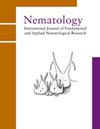Bioassay to characterise the effects of nematicidal compounds on Meloidogyne species
IF 1.2
4区 生物学
Q2 ZOOLOGY
引用次数: 0
Abstract
Summary A bioassay was developed to characterise the effects of nematicidal compounds and tested using low concentrations (0.125 and 0.25 mg l −1 ) of three nematicides: fluensulfone, fluopyram and fluazaindolizine. Germinating lettuce seeds with ca 2-3 mm roots were planted in a 5.5-cm-diam. Petri dish on agar containing the nematicides. Second-stage juveniles (J2) of Meloidogyne javanica and M. incognita were introduced to the agar plate immediately after planting. Alternatively, lettuce seeds were planted 48 h after introducing J2 to the plate. The number of J2 attracted to a root tip and J2 mobility were recorded 19 h after inoculation or planting, and infection rate and root length were recorded 5 days after planting. The three nematicides showed different effects on J2 of the Meloidogyne species. Fluensulfone did not inhibit infection by either species if the lettuce was planted immediately after inoculation, but their infection rates, and especially those of M. incognita , were reduced when lettuce seeds were planted 2 days later. Fluopyram reduced infection with M. javanica J2 at higher rates (>83.3%) than for M. incognita J2 (<58.4%) compared to the control, even without 48 h exposure before planting. Fluazaindolizine reduced M. incognita infection at high rates (>83.3%), although the J2 were attracted to the lettuce roots. Root lengths also showed differences in infection severity. This assay distinguished the effects of the three nematicides on the two Meloidogyne species and can also serve to screen compounds that inhibit nematode infection without killing Meloidogyne J2.生物测定法表征杀线虫化合物对丝虫病种的影响
开发了一种生物测定法来表征杀线虫化合物的效果,并使用低浓度(0.125和0.25 mg l - 1)的三种杀线虫剂进行了测试:氟砜、氟吡仑和氟氮唑嗪。发芽的生菜种子,根约2-3毫米,种植在5.5厘米直径的土壤中。含有杀线虫剂的琼脂培养皿。种植后立即将javanica和M. incognita二期幼体(J2)引入琼脂平板。或者,在将J2引入培养皿后48 h种植生菜种子。接种或播种后19 h记录J2在根尖上的吸附数量和J2的迁移率,播种后5 d记录侵染率和根长。3种杀线虫剂对丝虫病种J2的影响不同。接种后立即播种时,氟砜对两种病原菌的侵染率均无抑制作用,但2天后播种时,两种病原菌的侵染率均有所降低,其中以黑穗病菌的侵染率最高。与对照相比,即使在种植前未暴露48小时,氟吡喃对爪哇菊J2的感染率(83.3%)也高于对不认识菊J2的感染率(58.4%)。虽然J2被莴苣根部吸引,但氟唑嗪对隐殖僵菌的侵染率很高(83.3%)。根长也表现出感染严重程度的差异。该实验区分了三种杀线虫剂对两种旋律线虫的作用,也可以用于筛选抑制线虫感染而不杀死旋律线虫J2的化合物。
本文章由计算机程序翻译,如有差异,请以英文原文为准。
求助全文
约1分钟内获得全文
求助全文
来源期刊

Nematology
生物-动物学
CiteScore
2.60
自引率
33.30%
发文量
67
审稿时长
3 months
期刊介绍:
Nematology is an international journal for the publication of all aspects of nematological research (with the exception of vertebrate parasitology), from molecular biology to field studies. Papers on nematode parasites of arthropods, and on soil free-living nematodes, and on interactions of these and other organisms, are particularly welcome. Research on fresh water and marine nematodes is also considered when the observations are of more general interest.
Nematology publishes full research papers, short communications, Forum articles (which permit an author to express a view on current or fundamental subjects), perspectives on nematology, and reviews of books and other media.
 求助内容:
求助内容: 应助结果提醒方式:
应助结果提醒方式:


